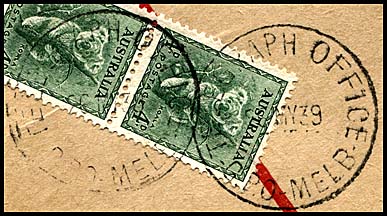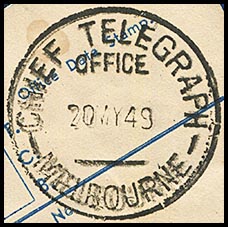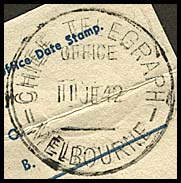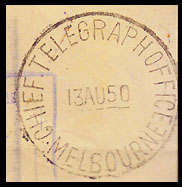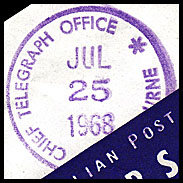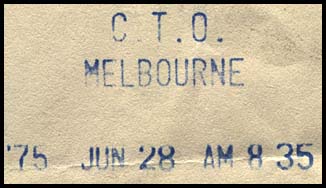Chief Telegraph Office - Melbourne.
- Australia 1901-1988
- New South Wales
- Overview of NSW
- Telegraph lines
- Telegraph Offices
- Date stamps
- Forms
- Envelopes
- Instructional annotation
- Collect
- Delayed
- Free
- Immediate Urgent
- Reply paid
- Rates
- Stamps
- 1871 Telegraph stamps
- 1885 proposal
- 1893 proposal
- Queensland
- South Australia
- Tasmania
- Victoria
- Western Australia
- International
- Special aspects
Details reviewed on this page are:
- Overview of the General Post Office;
- Overview of the Chief Telegraph Office;
Date stamps: - Telegraph Branch - GPO;
Telegraph Branch - Melbourne. - Telegraph Office;
- C.E.T.O./Melbourne;
Receiving Room/C.E.T.O.; - C.T.O./Melbourne;
- Chief Telegraph / Office / Melbourne (in steel);
Chief Telegraph Office / Melbourne (in steel);
Chief Telegraph Office / Melbourne (in rubber). - C.T.O./Melbourne (unframed in rubber).
- See also the following Slogan Cancellations used at Melbourne:
* Send a Telegram;
* Send Greetings by Telegram;
* Send Birthday Greetings by Telegraph ...;
* 100 Years Celebration ...;
* A Telegraphic Code Address ...;
* Other slogans used at Melbourne.
The first government building for postal services in Melbourne was opened in 1842 at the corner of Elizabeth and Bourke Streets.
The present Melbourne G.P.O was built between 1859 and 1907 at the same location. It was designed by the architect A.E. Johnson - who actually won second prize in a competition for the design. It now incorporates a wide mixture of architectural styles due to the time over which it was built.
The clock tower built at the intersection of the two streets is still used as a reference point to measure distances from Melbourne. Although an impressive tower by 1867 as shown below, subsequent construction raised in higher and made it more dominant.
In September 2001 a fire severely damaged the interior. The building now incorporates a wide variety of cafes outside and specialist shops inside - as well a Post Office.
A full description of the building as it was in the late 1860s is provided on page 1 of the Scientific American 12 August 1871.
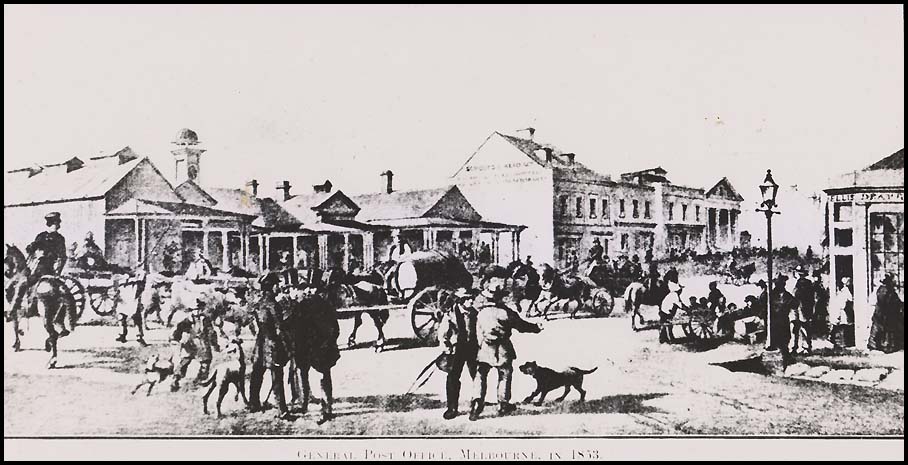 Melbourne Post Office and surrounding environs, in 1853. Ellis Drapers at right, Schults & Roio to left of lamp post. |
|
Postcard printed in Austria. |
 The Melbourne G.P.O. as it was at the end of the 1867 construction phase. Drawing printed on page 1 of Scientific American 12 August 1871. Elizabeth Street extends to the left and Bourke Street to the right. |
The Perth Inquirer of 17 July 1896 did report on a major incident:
"A Victorian Public Service Scandal.
'Ironing done here' might appropriately be a sign hung outside the General Post Office, Melbourne. Some of the young ladies employed there have been in the habit of utilising Government gas to heat their irons and have ironed their clothes within the departmental walls. So declare some of the higher officers".
Does this mean that you cannot trust a Melbournian or that the ladies in the Post Office care about their appearance more than many others? I think the latter!!
The original Central Telegraph Office was situated at the north-east corner of William and Little Bourke Streets. In his Report to the end of June 1857, McGowan noted (p. 7) that:
Some reports point out that it was not just the inconvenient position that was a problem with the first Telegraph Office in Melbourne. The Geelong Advertiser, in a broader statement described:
"When the telegraph was first opened between Melbourne and Williamstown, the Melbourne terminus was a wretched little two-roomed wooden shed, so frail in its structure as to render it necessary on a windy day to have the apparatus covered with a linen cloth to keep off the dust. Had it not been for the remonstrance of the Superintendant (Mr. McGowan) aided by a few broadsides from the Press, I do not believe two bricks of the new terminus would be now found together".
In 1857, the staff in the Melbourne Electric Telegraph Office consisted of a station master, a line inspector, a signal master and a messenger for town deliveries. This staffing was clearly less than that required.
Unfortunately, in McGowan's Report for the half year to June 1859, he states:
"The present office accommodation in Collins Street, having been found inadequate to the increasing requirements of the department, and superior apartments for the purpose having been offered at the Exchange Building at a considerably lower rental, it was deemed advisable to effect a change in the locality of the Central Office by accepting the tender made by the Exchange Company. A new office is therefore being fitted up in the Exchange building, in which improved arrangements are being introduced; and I entertain the hope that, while no loss to the revenue of the Department may accrue through the change, the public will find more satisfactory accommodation for the reception, transmission and delivery of telegrams than is now presented. It is anticipated that the new office will be opened for business by the 25th of the ensuing month (July 1859).
I have been informed, through the office of the Honorable the Commissioner of Public Works, that, in accordance with the authority conveyed by your minute upon my letter of 2nd April last, the necessary instructions have been issued for the preparation of plans and designs for the erection of a new station building to be situated near the new parliament buildings but, owing to there not being a sufficient amount of funds available for the purpose out of the Vote for the current year, it will not be possible to proceed with the structure until a new vote may have been obtained. The intended office at the eastern end of the city will be connected directly with the instrument in the central office and the two offices will be equally available to the public. The eastern office will provide greatly increased facilities, not only for the transaction of business during the sessions of Parliament, but also for the use of the inhabitants of East Melbourne generally".
Soon after the Office moved to new premises, The Age reported "The electric light was exhibited last evening for experimental purposes from the summit of the old Telegraph Office in William Street. The light was turned in every direction but chiefly towards Williamstown to afford the officials at the observatory there, who were previously made aware of the intended exhibition, an opportunity of estimating its effect at the distance intervening between them and Melbourne. The light as viewed from the adjoining streets was very brilliant at all times, but there was considerable irregularity in the effect produced. It appeared that the flame could not at any time be kept alive beyond a few seconds. These were, of course, the usual results of the unequal combustion of the charcoal, which invariably imparts an intermittent character to this most beautiful description of illumination. We have said that the light was at all times brilliant, but occasionally it was most intense, projecting a beautiful column of pale steel-hued light far out into the moonlit atmosphere, which seemed dark by contrast with its starlike brilliancy. The light, we were informed, was one intended to be used in the geodetic survey. From a short distance it seemed some four inches in diameter, but this was doubtless the effect of a reflector which formed part of the instrument used on the occasion, the entire of which is extremely compact and portable, being contained in a box no larger than an ordinary sized accordion".
The Government directed that, as from March 1864, the Telegraph Office should be closed on Good Friday and Christmas Day:
"As a sort of celebration of the first whole holiday they have had, the telegraph operators in Melbourne have sent a challenge to the post office to play an eleven from that establishment at cricket next Friday. Post Office immediately responded by sending up a list of the names chosen to do battle for them and preliminaries were soon arranged. The use of the Melbourne Ground and subsequently the East Melbourne ground was applied for but both were previously engaged and it was decided to play on the Eastern Hill ground. Wickets will be pitched at ten a.m., and a good day's sport may be looked for. "Lightning" is very confident but, as little or nothing is known of the post office players, it is impossible to say who will have the best of it".
(The Herald, 24 March 1864).
The Argus reported on 6 April 1869 that:
"a branch telegraph office will be opened to-day at the General Post Office, the entrance to which will be from Bourke Street. Communication has been opened with all stations, and messages will be received and transmitted the same as at the head office near the Custom House.
It is intended that messages sent - say, from Ballarat and directed to a person whose address is nearer the Post Office than the Head Telegraph Office should be transmitted direct to the Post Office branch, and thence delivered by messenger in the usual way. To avoid confusion in priority will, in practice, be perhaps the most difficult thing with this twofold convenience.
Suppose a share broker from the Hall of Commerce sends a message directed to his agent at Ballarat to buy some shares, and this message is delivered at the head office at eleven a.m. and a broker in Elizabeth Street delivers a similar message at the same hour at the post office; some little difficulty will no doubt arise. But suppose the operator at the post office was, at eleven a m., engaged in sending several messages to Ballarat, then it would be impossible to send from the head-office the one delivered at that hour until he had finished transmitting. This would give the Elizabeth Street message, even delivered a few minutes later, a rare chance of being delivered first.
As the authorities, however, have stretched so many wires to the new branch establishment, and fitted it up in every way to give increased accommodation to the public, these and other difficulties may be capable of being overcome".
On 15 July 1872, the new Telegraph Office was opened in the new location on the corner of Elizabeth Street and Little Bourke Street. It was not considered to be as imposing as the old Exchange building but the accommodation for the Public and Employees was far superior. This office was only designed to be temporary but it was anticipated that it would probably meet all requirements for several years or at least until the north wing of the General Post Office, had been erected for use as the Telegraph Office.
"The operating-room, where the slaves of the lamp pursue their avocations, sometimes far into the night, is 52ft. long and 40ft. wide. At night it is lighted with a sunlight, and each operator has also a gas-burner to himself. It is an eminently comfortable room. The instruments are ranged round the walls, forming a hollow square. There are 30 in all, and from the position in which Mr. James, the manager, and Mr. Payter, the assistant manager, sit, each operator can be seen at work by the officer in charge. The instruments on the western side represent the inter-colonial lines, those on the north the local lines, those on the east the coast lines and those on the south the northern lines to Sandhurst and Swan Hill". See elsewhere for a continued description of the operating room and the building.
 Extracted from 1874 Report by the Superintendent p. 20. |
And now part of the back-story. The Australasian of 31 May 1873, elaborated details of the arrangement for the Telegraph Office:
"The shareholders of the old Melbourne Exchange Company seem to know their way about. They may be trusted from home by themselves. A good many years ago - almost in the pre-historic period - they obtained from Government a valuable plot of ground on which to erect an Exchange. They earned out their part of the contract in a liberal spirit and erected a creditable building. It was a failure however. The merchants wouldn't go there and the proprietors found that they had on their hands a magnificent white elephant in carved freestone.
They were not, however, men without resource. They succeeded in letting the building (on Government ground) to Government for a Telegraph Office and paid good dividends out of the rent. But this arrangement gave out at last when the telegraph business was concentrated at the General Post Office. What was to be done? Not the proprietors. They have, I hear, been clever enough to sell the building to the Government for something between £5,000 and £6,000, sufficient to give the shareholders a handsome winding-up dividend. By whom was this transaction negotiated? And have any shares been picked up quietly by people in the secret"?
Simultaneously with the removal of the Chief Telegraph Office to Elizabeth Street, a branch telegraph and money order office was opened in the eastern end of the Custom House to overcome any problems the merchants who do business in the western half of the city might suffer from the change.
On 4 November 1874, the Hamilton Spectator reported that "The Board appointed to consider the desirability of establishing a Labour Bureau, has arrived at the conclusion that it was advisable that such an institution should be established. The suggestions relative to the scheme were considered and discussed. It was deemed necessary that a site should be obtained for the head office in Melbourne and the old telegraph office, now temporarily used as a Custom House, was regarded as a suitable building. An application has been made to the Government for the use of this building for this purpose, which has been referred to the proper department".
The Argus, on 16 October 1882, carried the following story:
"The necessity for a new central telegraph office has long been recognised, and three proposals are now before the Government for new offices:
- to purchase the premises of Messrs. Briscoe and Co. in Collins Street;
- to secure an available site at the corner of Queen and Bourke streets;
- to utilise the comparatively vacant space adjoining and at the rear of the Post-office.
These proposals will probably be considered at a meeting of the Cabinet which will probably be held to-day. Of the three, the premises of Messrs. Briscoe and Co. appear to be the most eligible although an objection is raised to their distance from the Post-office. Plans have been prepared for utilising the land adjoining the Post-office, but these will probably be abandoned, as the site will be most inconvenient to the public. At the side of the Post-office in Bourke street is an archway, which leads to a private roadway through into Little Bourke street. Next to this is a block of buildings which extends to another right of way, known as the Herald or Angel Lane. These buildings are used for business purposes, and are owned by private individuals. At the rear, however, and extending between the two lanes to Little Bourke street, is a strip of land in part owned and in part rented by the Government. On this strip, which is now used for stables and other out offices in connexion (sic) with the Posts and Telegraph department it is proposed to erect the new telegraph offices. It would undoubtedly be a most desirable position if the Government owned the frontage to Bourke street; but as the frontage is rented to business people, under an extended lease, it appears to must undesirable and inconvenient to erect a large public building at the rear of these premises. It is undesirable because the building would be in the background and it is inconvenient because the public would have to traverse a covered archway or corridor for about 150 feet before they reached the telegraph office, savings bank and other public offices. Some years ago the front premises referred to were offered to the Government for £20,000 but now they are valued at £50,000 and would probably not be sold for that sum" (page 8).
The Ballarat Courier of 26 October 1882 repeated an item from The Age which detailed "The Government have decided upon erecting a new Central Telegraph Office on the vacant land adjoining the Post Office. The plans for the new building have been prepared and will be submitted to the next Cabinet meeting on Monday. The building will consist of brick and will cost about £20,000. The entrance will be through the present archway in Bourke Street and it is intended to have the shipping news posted outside at the archway".
The Illustrated Australian News for 29 February 1884 continued with details:
"An agitation has been existing for some time with the view of inducing the Government to provide additional accommodation for the transaction of the telegraphic business, in Melbourne.
Various proposals have been made to this end, and at one time the Government,admitting the inadequacy of the present Telegraph Office for the rapidly increasing business, entered into negotiations for the purchase of the extensive premises in Collins Street formerly occupied by Messrs. Briscoe and Co., iron- mongers, which it was intended, should be devoted to the purposes of a telegraph office. The negotiations failed, however, on the question of terms and then Mr. Berry, the Postmaster-General, manifested a disposition to give favorable consideration to a proposal that the Office should be removed to the building at present used as the police court, in Swanston Street, adjoining the Town Hall.
This proposal, however, met with a good deal of opposition from the merchants in the western part of the city, and the vexed question has now been fairly settled by the determination, which has received the sanction of the Cabinet, to add another storey to the present Post Office, and devote the additional space thus gained to the use of the Telegraph Office. The plans in connection with the proposed alterations have already been prepared and it is expected that the work will be completed within two years. The additional storey will have the effect of greatly improving the appearance of the Post Office buildings".
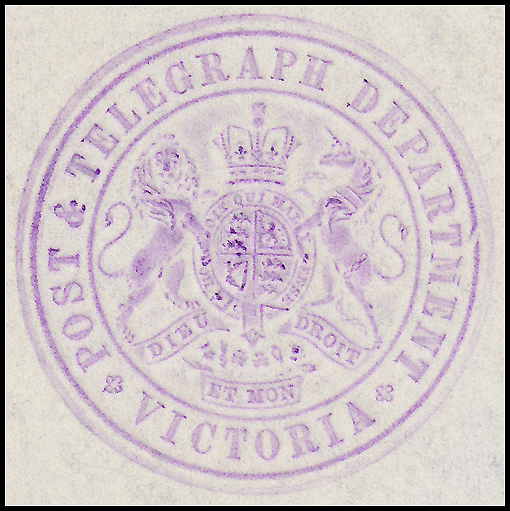 |
The importance attributed to the role of the Central Telegraph Office in Victorian life in the late 1860s and the dependency on telegraphic communication in particular is highlighted by questions asked by Mr. Richardson in the Victorian Legislative Assembly:
"Mr. RICHARDSON called the attention of the Government to the delay which occurred in the receipt in Melbourne of the intelligence of the wreck of the Victoria Tower, a passenger ship from England, which took place outside the heads on Sunday morning October 17. He stated that news of the wreck reached Geelong at eight o'clock, and an attempt was made by the officer in charge of the telegraph-office in that town to communicate it to Melbourne but the effort was not successful until about noon, in consequence of no one being on duty in the telegraph-office in Melbourne. The delay might have resulted in serious loss of life; and, to prevent such a contingency in the future, he suggested that there should be some person on duty night and day - on all days of the week - at the central telegraph-office in Melbourne.
Mr. COHEN observed that the honourable member was correct in saying that the information in regard to the wreck of the Victoria Tower did not reach Melbourne until about noon, in consequence of there being no person being in attendance at the telegraph-office. Care would be taken that such delay could not occur again" (p. 1986 of Parliamentary debates, Vol 9).
On 30 November 1869:
"Mr. RICHARDSON reminded the Minister of Customs that, some weeks before, he called his attention to the inconvenience attending the closing of the telegraph office in Melbourne on Sundays, as shown in the case of the wreck of the Victoria Tower. Similar inconvenience had since been experienced in connexion (sic) with the burning of the Lightning in Corio Bay; and last Sunday afternoon the news reached Cape Otway of the loss of the Marie Gabrielle but the fact was not known in Melbourne until Monday morning, because no officer was in attendance at the central telegraph station. He thought that these circumstances were sufficient to impress upon the Government the necessity of having some one always in attendance at the central telegraph station.
Mr COHEN explained that, in consequence of the representation made to him, he communicated with the Telegraph Department, in order that some one might be kept on duty, night and day, at the central station" (p. 2350 of Parliamentary debates, Vol 9).
The central office was referred to as the Telegraph Branch until changes of names:
- _____ to the Chief Electric Telegram Office (C.E.T.O.);
- _____ to the Chief Telegraph Office (C.T.O.)
A possible first Zoom/Google meeting in the Australian Colonies.
Telegraph messages were conventionally sent along the wires without sender or receiver being present. Nevertheless "necessity is the father of invention" in many circumstances.
In February 1876, due to travel circumstances, a meeting was held using the telegraph for FOUR HOURS!! As it is not clear if that meeting had one participant in the Melbourne Telegraph Office, details are included elsewhere.
Importantly, the Electric Telegraph Office had a rowing squad which participated in regattas at Melbourne, Ballarat and Geelong. The Melbourne Sportsman of March 1882 noted "The Victorian amateur eight and Banks are promising well; but the two last-mentioned are not doing good work. George Wing has the Electric Telegraph clinker four, with Johnston stroke, under his care. They are doing fair work and may trouble their opponents on the day. Paice is looking after the Yarra Yarra junior eight, who are beginning to shape well. ... Mr. Greenland has just finished a four-oar clinker for the Electric Telegraph Office Club, with raking slides (a la Hanlan), and all the other improvements".
The date stamps for the Chief Telegraph Office.
| Telegraph Branch/ G.P.O.
There are 5 formats for the date stamp with these words and letters: Format 1: Two line date and 4 digits in the year.
|
.jpg) 27 November 1883. Used on VC-EO-8. |
 19 June 1884. Used on VC-EO-8. |
Format 2: Two line date with two digits for the year.
|
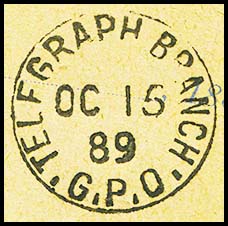 15 October 1889. Used on a receipt for a Foreign Telegram. |
Format 4: Two line date with two digits for the year..
Diameter: 25 mm. |
 31 July 1888. |
|
| Format 5: Two line date with two digits for the year. Dots around G.P.O. are in the middle of the letters T and H. Stops after each letter of G.P.O.
|
 10 February 1897. Used on VC-DO-18. |
 16 November 1898. Used on VC-DO-16B. |
Two line date with two digits for the year. Thin letters.
|
 25 February 1901. |
 23 September 1901. Used on VC-DO-16C. |
Two line date with two digits for the year. Thick letters.
|
Used on AI-DO-1. |
Used on VI-DO-2C. |
Telegraph Branch Duplex with Melbourne at the right. Two line date with two digits for the year. Has Counter Number 1 above date.
|
 20 September 1884 Counter number above the date. Used on VC-EO-8. |
|
Telegraph Branch Duplex with Melbourne at the right. Two line date with two digits for the year. No Counter Number.
|
 20 January 1885. Used on VC-DO-17B. |
|
Telegraph Branch/ Melbourne. Two line date.
|
6 December 1901.
|
|
Two line date.
|
 |
 18 June 1963. Phoenix May 2023 Lot 2386. |
| C.E.T.O./ Melbourne. Thick letters.
See also the use of this date stamp on 27 February 1912 on the extremely rare delivery form VI-DO-4 complete with TELEGRAM seals. |
Used on VI-DO-1C Has a DELAYED/LINES INTERRUPTED hand stamp. |
Used on a Reply Paid form AE-RO-1B. |
|
|
|
| C.E.T.O./ Melbourne - Vic.
|
Used on VI-DO-3Ea |
|
|
|
Used on AE-DO-1E. |
|
3 mm arcs on each side.
|
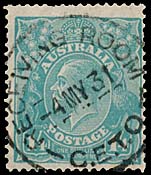 4 May 1931. |
|
|
 4 February 1936. Used on IAX-DO-4A. Rated: RRRR used on a telegram. |
| C.T.O./ Melbourne: SC1-CTO.
|
 16 March 1928. Used on AB-DO-4B. |
 26 June 1928. |
Chief Telegraph/ LEFT: A unique item. Two different proof strikes with a date of 25 November 1927. Two telegraphic strikes on a dozen or so large specimen sheets being discarded by a printer which comprised the archive of jobs he had done. The sheets contain many kinds of handstamps for commercial purposes as well as many postal handstamps. |
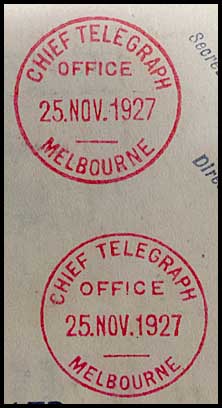 Provenance: Dave Elsmore.
|
|
| OFFICE lowered from top words.
2 digits for year.
|
Used on AB-DO-4Db. |
Used on AB-DO-8Bd (1934). |
2 digits for year.
|
Used on AB-DO-7Bb. |
Used on AW-DO-9Ba (40). |
| OFFICE lowered from top words.
2 digits for year.
|
 19 November 1934. Used on IAX-DO-4A. |
|
| OFFICE lowered from top words.
2 digits for year.
|
Used on AB-GCF-39C. |
Used on AW-DO-10B (47). |
OFFICE lowered from top words.
Number in the Census (on telegram): 3. |
 28 March 1940. Used on Xmas Greetings form |
 24 December 1944. Used on a Military telegram to Toorak |
2 mm arcs for separation of Melbourne.
Diameter: 30 mm Used in black: 11 June 1942 |
OFFICE spans 10 mm. |
|
Chief Telegraph Office/ The feature of these date stamps is that the words CHIEF TELEGRAPH OFFICE curve continuously around the top of the circumference and the word MELBOURNE is at the base. Both the month and the year always is recorded with 2 digits. |
||
No separation marks around Melbourne.
|
 22 December 1926. Used on AB-DO-4A. |
|
Dots for separation around Melbourne. Left dot centered but right dot on the outside of the letters.
|
 19 November 1934. Diameter: 30 mm Inside distances: Used on AB-GVF-34. |
|
Dots for separation around Melbourne. Both dots around Melbourne are on the outside.
|
Used on IAX-DO-4D. |
A second example dated 15 July 1948 is recorded on the same type of form but the lettering has been smudged especially in the lower half below the date. |
One dot before MELBOURNE
|
Used on IAO-DO-1B (Heard Island to Glen Iris, Vic).
|
Used on AW DO-10 (49). |
Dots centered on letters before and after Melbourne.
|
Used on AW-DO-10A (45).
|
Used on an OTC International form for incoming cables IAO-DO-2A. This message originated in Antarctica. |
| Arcs for separation around Melbourne.
1 mm side arcs in the center of the letters.
|
Rounder letters - especially for the G, the B and the O. |
7 March 1956. Used on AA-DO-13B.
|
1 and 2 mm side arcs in the center of the letters.
|
|
|
Two 2 mm arcs in the centre of the letters.
|
Used on AW-DO-9B (42). |
Used on AW-DO-10B (43). |
No mark before M(el) but a centered 1 mm arc between E-E.
|
 17 September 1955. Used on AW-GCF-54B. |
|
Dot before MELB... and thick 1 mm dash between ...ICE and ...RNE.
|
|
|
|
 £2 green Arms. 24 July 1962. |
 £1 blue Arms. 20 July 1962. |
 Detail showing the dash before C(hief) |
| Chief Telegraph Office - rubber handstamp. MELBOURNE at base. The date could rotate within the frame and so it appears in various positions. |
|||
|
RC1 - CTO. Has stars with 5 points for separation. Used in violet: Diameter: 31 mm. Rated: RR. Number in the Census: 11
|
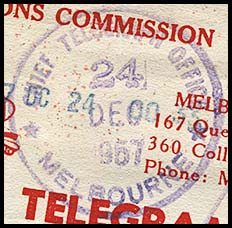 24 December 1957. Used on an OTC delivery form IAO-DO-2 from London. See also the unique Carlton rubber rectangular date stamp for the suburban Carlton Telegraph Office. |
 17 February 1966. Used on AA-RO-10 |
The same format having stars with 5 points but with the top inscription rotated. Used in blue: 16 February 1959. The similar format was used at other local Post Offices - for example Crows Nest (NSW), Gilgandra (NSW), Goulburn (NSW), Pyrmont (NSW). |
|
|
|
Has side arcs instead of stars for separation. Used in violet: Diameter: 31 mm. |
 19 December 1962. Used on AW-DO-10-C (59). |
 17 December 1969. Used on AA-DO-13B. |
|
Has 6 pointed stars for separation. Has month before day. Used in violet: 25 July 1968. Diameter: 29 mm. Rated: RR. Number in the Census: 1.
|
Used on IAA-TT-7. |
||
| C.T.O./MELBOURNE rubber handstamp. Straight line handstamp.
|
Used on AA-DO-13B. |
Used on AA-DO-13D. |
Straight line handstamp. Letters are elongated.
|
Used on AA-DO-13D. |
|















